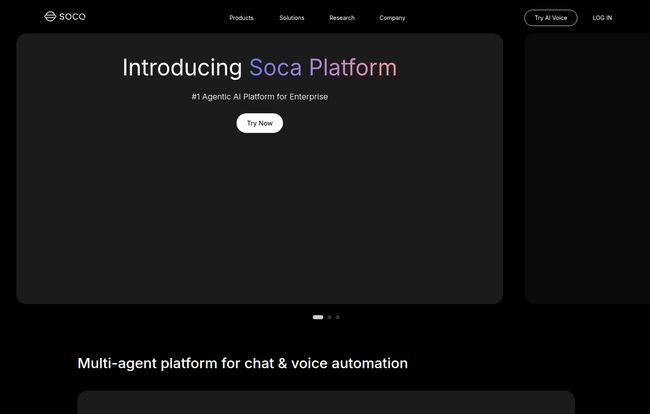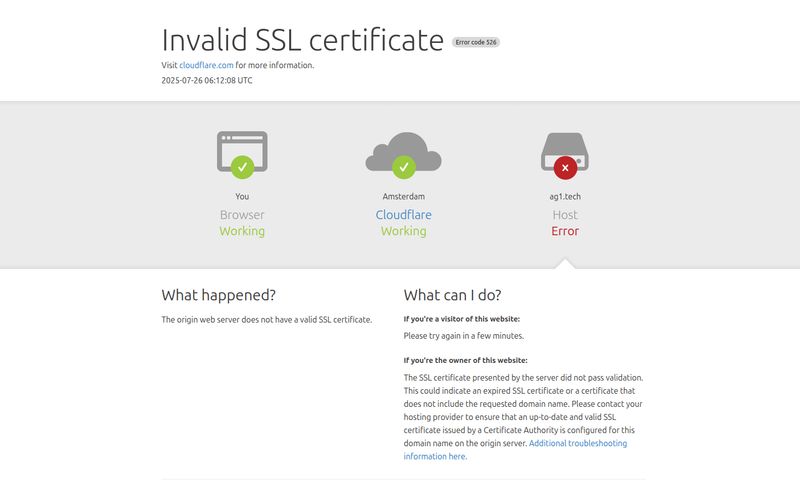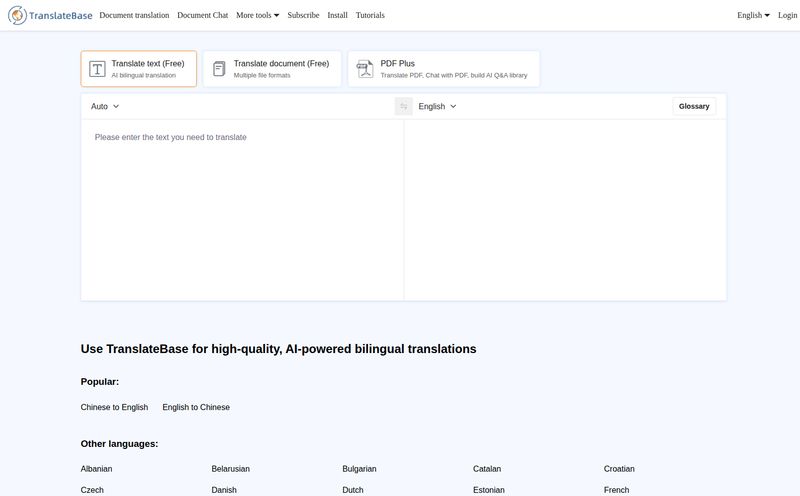For years, every other company in my inbox has been screaming about their “revolutionary” AI chatbot. And for years, most of them have been… well, a bit rubbish. Clunky, robotic, and about as intelligent as a pet rock. Building truly good conversational AI has always felt like one of those things that required a team of people with PhDs, a mountain of cash, and the patience of a saint.
So, when I stumbled upon Soca AI, my professional skepticism was cranked to eleven. Another platform promising the world? But then I saw the magic words: no-code and multi-agent platform. My ears perked up. Could this be it? A way for regular businesses, for marketing teams, for customer support leads—not just hardcore developers—to build a proper team of AI assistants?
I decided to put my jaded-blogger hat aside for a minute and take a closer look. What is this thing really about?

Visit Soca AI
So, What Exactly is The Soca AI Platform?
Let’s break it down without the corporate jargon. Soca AI is a platform that lets you build and manage your own AI agents for chat and voice automation. Think of it less like building a single, clunky chatbot and more like assembling a team of specialists. You can create an agent to handle initial customer questions, another one to qualify sales leads, and maybe a third one to help with internal IT support. All working together.
The real kicker? It’s designed to be a no-code environment. The goal is to remove the massive technical barrier that usually comes with this kind of tech. Instead of writing endless lines of Python, you’re meant to be able to construct these agents through a more visual, intuitive interface. This, for me, is the most interesting part. It’s a move toward democratizing powerful tech, taking it out of the server room and putting it into the hands of the people who actually design the customer interactions.
More Than Just a Chatbot: The Core Features
Okay, so the concept is solid. But a platform is only as good as its tools. From what I can gather, Soca AI isn't just a one-trick pony. It's packing some serious capabilities that caught my eye.
Building AI Agents Without Writing Code
This is the headline feature, and for good reason. For too long, the people with the operational knowledge (like support managers) have had to try and translate their needs to developers, with a lot getting lost in translation. A no-code platform means the person who understands the ideal customer flow can actually build that flow. It dramatically speeds up the process from idea to implementation. This is the kind of thing that can turn a six-month development project into a two-week sprint. Huge.
A Team of Agents, Not a Solo Act
The “multi-agent” system is another big differentiator. I've always felt that trying to make one single AI do everything is a recipe for disaster. It gets confused, the logic gets tangled, and the user experience tanks. Soca AI’s approach is more like managing a department. You have different agents with different skills. Your “Receptionist Agent” can greet users and route them to the right place. Then, the “Sales Agent” can take over for product questions, or the “Support Agent” can handle troubleshooting. It's a much smarter, more scalable way to think about automation.
An In-House Voice and Dubbing Studio
Now this is cool. Soca AI includes a Voice & Dubbing Studio with over 50 voices in more than 20 languages. As someone who’s worked with companies trying to go global, I can tell you that content localization is a monster of a task. Creating a marketing video or a training module and then being able to generate high-quality voiceovers in multiple languages, right within the same platform? That’s not just a convenience; it’s a massive competitive advantage. It cuts down on time, cost, and the logistical nightmare of hiring voice actors for every single region.
The Intriguing Mysteries: SAM, S.M.I.L.E, and Genova
While looking through their site, I noticed a few tantalizing but vague feature names: SAM (Small Action Model), S.M.I.L.E, and Genova. There isn’t a ton of public info on what these are, which is a classic tech company move to build a little mystique. But I have my theories.
- SAM (Small Action Model): This sounds like a direct response to the giant, resource-hungry Large Language Models (LLMs). A “small” model is likely fine-tuned for very specific, quick tasks. Think less “write me a sonnet” and more “book a meeting” or “find order status.” It’s efficient and focused.
- S.M.I.L.E: If I were a betting man, I’d guess this has something to do with sentiment and emotional analysis. Maybe something like… Sentiment & Mood Intelligence Logic Engine? Being able to gauge if a customer is happy, frustrated, or confused in real-time is the holy grail for automated support.
- Genova: This one’s a bit more of a black box. Given the context of generative AI, it could be a proprietary engine for creating more complex content or workflows.
This is pure speculation on my part, of course. But the fact that they're hinting at these deeper capabilities suggests they have ambitions beyond simple Q&A bots.
Who Is This Platform Actually For?
Soca AI is clearly aiming for the enterprise market. The talk of “enterprise-grade security,” SSO, and encryption confirms this. They list specific solutions for industries that are usually bogged down by legacy systems and a deep need for better customer interaction. We're talking about:
- Banking & Finance: For automating fraud alerts, customer onboarding, and account queries.
- Marketing: For lead generation, qualification, and personalized campaigns at scale.
- Healthcare: For appointment scheduling, patient reminders, and answering common health questions (with proper safeguards, one hopes).
- Telecommunications: For handling the endless stream of billing questions, tech support, and plan upgrades.
But honestly, with a no-code builder, its potential audience is much wider. I could see mid-sized e-commerce shops using it to build a killer post-purchase support agent or SaaS companies creating an interactive onboarding guide for new users.
The Elephant in the Room: Soca AI Pricing
Ah, the part you've been waiting for. How much does it cost? Well, I put on my detective hat, went searching for the pricing page, and was greeted with... a “The requested page is not available” error. Classic. This is pretty standard for enterprise-focused SaaS platforms. They want you to get on a call with a sales rep so they can tailor a package for you.
So, no, there’s no public pricing table. You won’t find a neat “Basic, Pro, Enterprise” chart. You’ll have to hit that “Try Now” or “Talk to support” button and have a conversation. While I always prefer transparent pricing, I get it. A setup for a 10,000-person bank is going to be wildly different from a 50-person marketing agency. Expect custom quotes based on your usage, the number of agents, and the specific features you need.
My Honest Take: The Good and The Could-Be-Better
So, where do I land on Soca AI? I’m cautiously optimistic. What I really like is the ambition. The combination of a no-code builder, a multi-agent architecture, and powerful generative voice tools is a potent mix. It shows a deep understanding of what businesses actually need to make automation work in the real world.
On the other hand, the lack of transparency around pricing is always a bit of a hurdle. And the vagueness around advanced features like S.M.I.L.E and Genova makes it hard to gauge the platform's full power without committing to a demo. There's probably a learning curve, too—no-code doesn't mean no-effort. You still need to think logically about the flows you're building.
But overall, it strikes me as a very serious contender in the conversational AI space, especially for companies that have felt locked out by the technical complexity of it all.
Frequently Asked Questions about Soca AI
- 1. What is Soca AI in simple terms?
- Soca AI is a platform that lets businesses create their own AI assistants for chat and voice without needing to write code. You can build multiple specialized agents that work together to automate tasks like customer service, sales, and internal support.
- 2. Is Soca AI difficult to use for non-developers?
- It's designed as a “no-code” platform, which means its primary goal is to be accessible to people without a technical background. While there will be some learning involved to understand how to design effective conversations, you won't need to be a programmer to use it.
- 3. What makes the “multi-agent” feature special?
- Instead of one AI trying to do everything, you can build a team of AIs, each with a specific job. This is more efficient and scalable. For example, one agent handles greetings, and then passes the customer to a more specialized agent for sales or support.
- 4. Does Soca AI support languages other than English?
- Yes. A key feature is its Voice & Dubbing Studio, which supports over 50 different voices across more than 20 languages, making it a strong tool for international businesses.
- 5. Is Soca AI free?
- The pricing isn't public, which is common for enterprise software. It's almost certainly a paid platform with costs based on your specific needs. You'll need to contact their team for a quote.
Is Soca AI Worth Your Time?
Here’s my final thought. If you’re a business leader who’s been curious about AI automation but scared off by the complexity and cost, Soca AI looks like it could be a very compelling answer. The focus on no-code accessibility is, in my opinion, exactly what the industry needs right now.
It’s not some far-off futuristic concept; its a practical set of tools for solving real-world business problems. While I'd love to see more transparency on pricing and those mystery features, the platform’s core promise is strong. It’s definitely one to watch, and if you’re in the market for this kind of solution, it seems well worth the time to book a demo and see it in action.
Reference and Sources
All information and analysis are based on the public-facing content available on the Soca AI website as of the time of this writing. For direct information or a demonstration, please refer to their official site.



